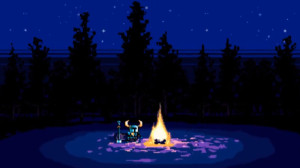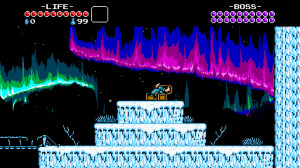
Shovel Knight. It promises to be a pretty good game, and all the early word I’ve heard so far only reinforces that promise.
Happy Shovel Knight Day, readers. But put down that 3DS or Wii U gamepad or keyboard(?) and take a seat with me to go over just what it is that Shovel Knight has going for it. Admittedly it is a lot of things, not the least of which is simple good will fostered by a small and attentive developer that was willing and evidently able to add many requested features to the game. But one thing stands out to me as a key factor in Shovel Knight‘s appeal above the rest and that is the 2D side scrolling perspective. Being as this post goes live on a Thursday and I have not acquired an early copy of the game I therefore cannot say with certainty how much I will enjoy the title aside from whatever certainty I am provided from the ample pre-release coverage. And there has been a lot of pre-release coverage of this game to show off the beautifully designed sprite-based presentation.
Side scrollers have enjoyed a resurgence lately thanks to the increased ease of developing what once was a top of the line presentation style, and also from the nostalgia value that seems to be the source of most funding on Kickstarter. But not all side scrollers today are made the same as Shovel Knight which is aiming for a very retro simplified look. Where newer side scrollers go off the tracks for me is when they try too much to reinvent the wheel often by adding elements that serve little purpose. In particular I am almost always disappointed by the gameplay of 2D side scrollers with 3D elements, sometimes referred to as 2.5 (two-and-a-half) D games. The precision afforded by well designed sprite graphics seems to be harder to convey in 2.5D games where the character models tend to move more slowly and the platforming elements commonly integral to gameplay feel less clear. It can be done, but I have yet to find a 2.5D sidescroller that made its movements look and feel as precise as a good NES Mega Man. Many of the earlier New Super Mario games had this problem for me. Mario just did not feel as responsive as he did in Mario 3 or the other 2D titles, however I have not lost hope on 2.5D side scrolling games. Although it looks a bit derivative, the newly announced Yoshi’s Wooly World has me optimistic and I think gives a good excuse to render the elements of a sidescroller in 3D.
The other major pit fall of modern side scrollers is over-producing the animation. In newer sprite-based games where the technique is cheap and size limits are huge, developers can sometimes go overboard with that extra wiggle room. I have discussed previously one of the benefits of limitations is keeping the project focused and removing excess and I think this is one example where limits would help. In an otherwise fantastic game like Dust: An Elysian Tale, the game looks amazing with silky smooth animation and copious frames of it to boot. But all those extra frames of animation can make the game feel slower than I prefer my 2D games to be. Developer Vanillaware, maker of the Muramasa games, seems to have a similar style but I have not played those and would be curious to see if the same hold true for those games. At any rate, while Dust proved to be a fun challenge I missed the snappiness of simpler sprite-based graphics. While simpler spirtes may not be able to convey studio animation quality visuals, simpler sprites feel like a very important element of a game where positioning is a key factor.
Aside from 2D side scrollers being a personal favorite of mine, I am being very positive about Shovel Knight because there is another important factor working for it that I already mentioned. The potent and growing nostalgia factor in games continues to be a driving force behind the kinds of titles produced, often from indie teams, and will continue to be a fascinating subject for this industry in the coming years. Shovel Knight is one in a chorus of games aimed at courting the lifelong gamer, aged in their late twenties to mid thirties, who grew up on NES era titles and for who the game’s presentation sends strong reminders of sitting by a small CRT television on the floor with classics like Mario and Contra. Much of the game seems to intentionally recall aspects or gameplay mechanics of old but well known side scrollers. The protagonist design and the various villains give a strong Mega Man vibe, which is a title that all but singularly epitomizes the idea of “NES-hard” games. The downward jumping attack looks reminiscent of the DuckTales pogo-cane wielded by Scrooge. Alongside old game staples like a score mechanic, money collecting, and only a cursory level of plot developemt, Shovel Knight looks to be a well calculated mash up of 8- and 16-bit game tropes. And while this might engender in me some degree of cynicism, I cannot seem to muster anything other than anticipation for this seemingly fine tuned game. Many other examples of the recent indie 2D boom have managed to pass me by with only feelings of disinterest, but this title among only a few others (like Chasm!) has stayed on my radar all through its long Kickstarter development cycle. In fact I would not be surprised if the powerful nostalgia element that this game has benefited from begins to take on a different shape in the not-too-distant future. While today’s indie teams are producing titles that NES and SNES gamers grew up on, I have a feeling it will not be long before the same will be said for gamers that pine for the N64 and PS1 days. Small budget low-poly games will become the next indie love affair the same way 2D currently is, but maybe I will expand on this thought another time.
So how much do you plan on playing the newly released Shovel Knight? I will probably be spending most of my free time today delving into its crisp sprite-based nostalgic goodness. What platform will you be buying it on? I am tempted to keep as many games as possible on my PC for simple convenience sake, but I do not own a controller with a good D-pad for my PC. Maybe I will get it on the Wii U instead. Maybe you should weigh in on this whole nostalgia business down below in the comments. Maybe I mean definitely instead of maybe. Probably.
